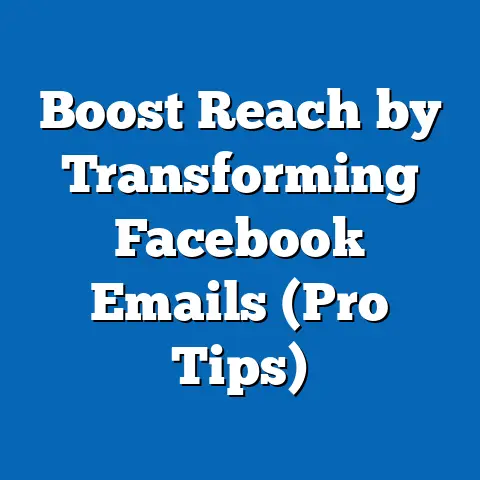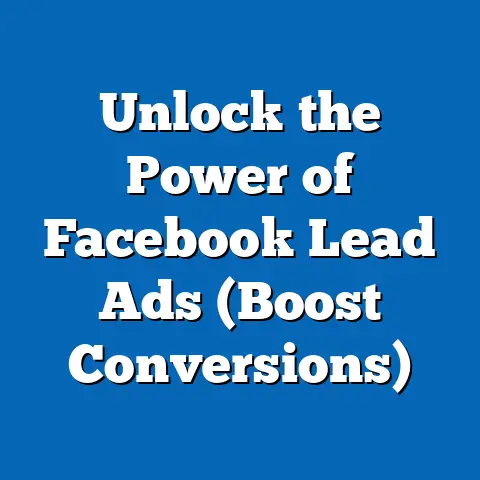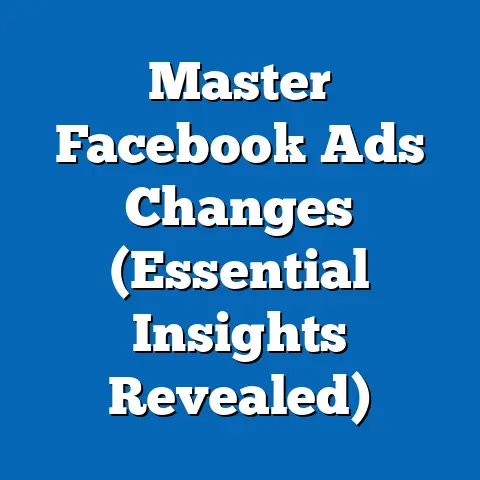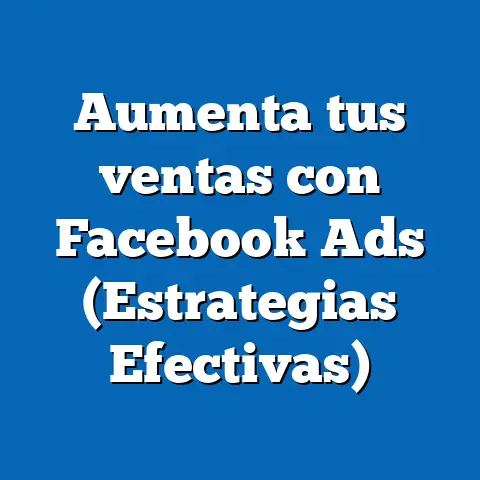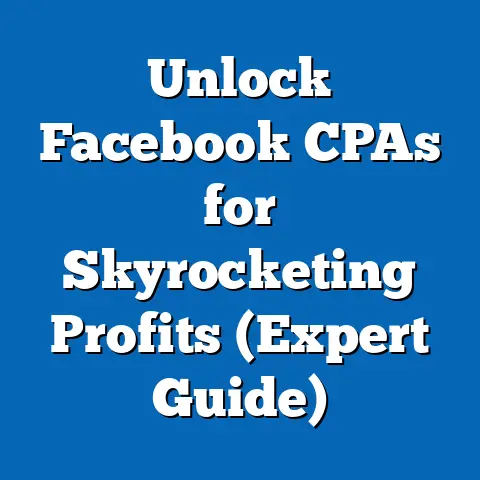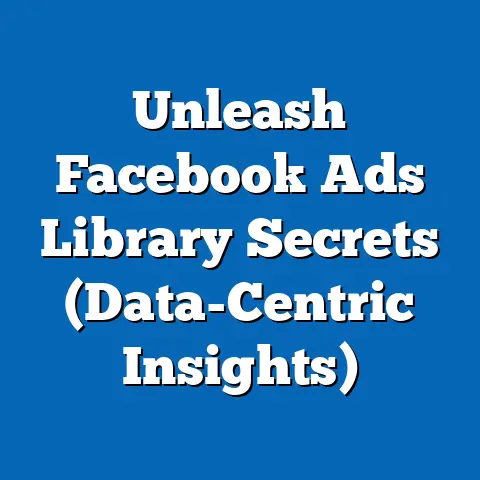Master Facebook Ads Best Practices (Essential Strategies for 2025)
“Since we started using Facebook Ads, our sales have skyrocketed. The ability to target our ideal customers has turned our marketing efforts into a well-oiled machine.” – Sarah Johnson, Owner of Trendy Boutique.
Sarah’s words perfectly capture the power of Facebook Ads. As we move into 2025, mastering Facebook Ads has become absolutely essential for businesses of all sizes. In today’s digital landscape, it’s no longer enough to simply have a Facebook presence; you need to strategically leverage the platform’s advertising capabilities to reach your target audience, drive conversions, and ultimately, grow your business. Staying updated with the latest best practices is crucial to maximize your return on investment (ROI) and ensure your advertising efforts are as effective as possible. I’ve seen firsthand how businesses that embrace these strategies thrive, while those that lag behind struggle to keep up. This guide will provide you with the knowledge and tools you need to navigate the ever-evolving world of Facebook Ads and achieve your business goals in 2025.
Understanding the Facebook Ads Ecosystem
Before diving into the nitty-gritty, it’s important to understand the fundamentals of the Facebook Ads ecosystem. Think of it as the foundation upon which all your advertising efforts will be built.
Overview of Facebook Ads
Facebook Ads, now part of Meta’s advertising platform, has undergone a remarkable transformation since its inception. What started as simple banner ads has evolved into a sophisticated, data-driven advertising powerhouse. With over 2.9 billion monthly active users, Facebook offers unparalleled reach and targeting capabilities.
I remember when Facebook Ads first started gaining traction. Initially, many businesses were skeptical, viewing it as just another social media fad. However, as the platform matured and the targeting options became more refined, it became clear that Facebook Ads was a game-changer. I personally witnessed small, local businesses experience exponential growth simply by running targeted ads to their ideal customers. The key was understanding the platform’s potential and adapting to its ever-changing landscape.
Key Features
Facebook Ads offers a diverse range of ad formats, each with its own unique strengths and benefits. Here’s a quick rundown:
-
Image Ads: Simple yet effective, image ads are a great way to showcase your product or service. They’re easy to create and can be highly engaging when paired with compelling visuals and copy.
-
Video Ads: Video is king in the digital world, and Facebook is no exception. Video ads are incredibly powerful for capturing attention, telling stories, and showcasing your brand’s personality.
-
Carousel Ads: These allow you to display multiple images or videos in a single ad, making them perfect for showcasing a range of products or highlighting different features of a single product.
-
Collection Ads: Primarily used for e-commerce, collection ads allow users to browse and purchase products directly from the ad.
-
Slideshow Ads: A cost-effective alternative to video ads, slideshow ads combine a series of images with music or text to create a visually appealing experience.
Image Ads: Simple yet effective, image ads are a great way to showcase your product or service. They’re easy to create and can be highly engaging when paired with compelling visuals and copy.
Video Ads: Video is king in the digital world, and Facebook is no exception. Video ads are incredibly powerful for capturing attention, telling stories, and showcasing your brand’s personality.
Carousel Ads: These allow you to display multiple images or videos in a single ad, making them perfect for showcasing a range of products or highlighting different features of a single product.
Collection Ads: Primarily used for e-commerce, collection ads allow users to browse and purchase products directly from the ad.
Slideshow Ads: A cost-effective alternative to video ads, slideshow ads combine a series of images with music or text to create a visually appealing experience.
The Facebook Ads Manager is your command center for all things advertising. It’s where you create, manage, and analyze your campaigns. Some key functionalities include:
-
Campaign Creation: Set your campaign objectives, choose your target audience, and select your ad placements.
-
Ad Set Management: Define your budget, bidding strategy, and schedule for each ad set.
-
Ad Creation: Design your ads with compelling copy, visuals, and calls-to-action.
-
Reporting and Analytics: Track the performance of your ads and gain valuable insights into your audience and campaign effectiveness.
Campaign Creation: Set your campaign objectives, choose your target audience, and select your ad placements.
Ad Set Management: Define your budget, bidding strategy, and schedule for each ad set.
Ad Creation: Design your ads with compelling copy, visuals, and calls-to-action.
Reporting and Analytics: Track the performance of your ads and gain valuable insights into your audience and campaign effectiveness.
Targeting Capabilities
One of the biggest advantages of Facebook Ads is its incredibly granular targeting capabilities. You can target users based on a wide range of factors, including:
-
Demographics: Age, gender, location, education, relationship status, and more.
-
Interests: Hobbies, passions, and interests based on their activity on Facebook.
-
Behaviors: Purchase history, online activities, and device usage.
-
Connections: Target people who are connected to your Facebook page, app, or event.
Demographics: Age, gender, location, education, relationship status, and more.
Interests: Hobbies, passions, and interests based on their activity on Facebook.
Behaviors: Purchase history, online activities, and device usage.
Connections: Target people who are connected to your Facebook page, app, or event.
Audience segmentation is crucial for maximizing the effectiveness of your ads. By dividing your target audience into smaller, more specific groups, you can tailor your messaging and visuals to resonate with each group individually.
Custom Audiences allow you to upload your own customer data (e.g., email addresses, phone numbers) to target your existing customers on Facebook. This is a great way to re-engage past customers or promote new products to your loyal fanbase.
Lookalike Audiences are one of the most powerful targeting tools on Facebook. They allow you to find new customers who are similar to your existing customers. Simply upload your customer data, and Facebook will create an audience of users who share similar demographics, interests, and behaviors. I’ve personally seen Lookalike Audiences generate incredible results for businesses, often outperforming other targeting methods.
Key Takeaway: Understanding the Facebook Ads ecosystem, including ad formats, Ads Manager functionalities, and targeting capabilities, is essential for creating effective and successful campaigns. Experiment with different ad formats and targeting options to find what works best for your business.
Crafting Compelling Ad Content
Now that you understand the basics of the Facebook Ads ecosystem, let’s talk about creating ad content that grabs attention, resonates with your target audience, and drives conversions.
Copywriting Best Practices
Your ad copy is your opportunity to connect with your audience, communicate your value proposition, and persuade them to take action. Here are some copywriting best practices to keep in mind:
-
Know Your Audience: Understand their needs, desires, and pain points.
-
Highlight Your Value Proposition: Clearly communicate the benefits of your product or service.
-
Use Strong Headlines: Grab attention and pique their interest.
-
Keep It Concise: Get to the point quickly and avoid jargon.
-
Include a Clear Call-to-Action (CTA): Tell them exactly what you want them to do (e.g., “Shop Now,” “Learn More,” “Sign Up”).
Know Your Audience: Understand their needs, desires, and pain points.
Highlight Your Value Proposition: Clearly communicate the benefits of your product or service.
Use Strong Headlines: Grab attention and pique their interest.
Keep It Concise: Get to the point quickly and avoid jargon.
Include a Clear Call-to-Action (CTA): Tell them exactly what you want them to do (e.g., “Shop Now,” “Learn More,” “Sign Up”).
I’ve found that using the AIDA (Attention, Interest, Desire, Action) framework can be incredibly helpful when writing ad copy. First, grab their Attention with a compelling headline or visual. Then, pique their Interest by highlighting a problem or opportunity. Next, create Desire by showcasing the benefits of your product or service. Finally, prompt them to take Action with a clear and compelling CTA.
Visual Elements
In the visually-driven world of social media, your ad visuals are just as important as your ad copy. High-quality images and videos can capture attention, communicate your brand’s personality, and drive engagement.
Here are some guidelines for choosing visuals:
-
Use High-Resolution Images: Avoid blurry or pixelated images.
-
Choose Relevant Visuals: Make sure your visuals are relevant to your product, service, and target audience.
-
Use Eye-Catching Colors: Experiment with colors that stand out and grab attention.
-
Showcase Your Product in Action: Demonstrate how your product or service solves a problem or improves their lives.
-
Keep It Authentic: Avoid overly staged or generic images.
Use High-Resolution Images: Avoid blurry or pixelated images.
Choose Relevant Visuals: Make sure your visuals are relevant to your product, service, and target audience.
Use Eye-Catching Colors: Experiment with colors that stand out and grab attention.
Showcase Your Product in Action: Demonstrate how your product or service solves a problem or improves their lives.
Keep It Authentic: Avoid overly staged or generic images.
I’ve noticed that ads with user-generated content (UGC) often perform exceptionally well. UGC feels more authentic and relatable than traditional marketing materials, and it can be a powerful way to build trust and credibility with your audience.
Ad Placement Strategies
Facebook offers a variety of ad placements, including:
-
Facebook News Feed: The most common and often most effective placement.
-
Instagram Feed: Ideal for visually-driven brands and products.
-
Facebook Marketplace: A great option for reaching users who are actively looking to buy products.
-
Facebook Right Column: A less intrusive placement that can be effective for brand awareness campaigns.
-
Instagram Explore: Reaches users who are actively discovering new content.
-
Audience Network: Extends your reach beyond Facebook and Instagram to a network of partner websites and apps.
Facebook News Feed: The most common and often most effective placement.
Instagram Feed: Ideal for visually-driven brands and products.
Facebook Marketplace: A great option for reaching users who are actively looking to buy products.
Facebook Right Column: A less intrusive placement that can be effective for brand awareness campaigns.
Instagram Explore: Reaches users who are actively discovering new content.
Audience Network: Extends your reach beyond Facebook and Instagram to a network of partner websites and apps.
Choosing the right ad placement depends on your campaign goals, target audience, and ad format. For example, video ads tend to perform well in the Facebook and Instagram feeds, while image ads can be effective in the right column and Audience Network.
Key Takeaway: Crafting compelling ad content involves writing persuasive copy, choosing high-quality visuals, and selecting the right ad placements. Experiment with different combinations to find what resonates best with your target audience and drives the desired results.
Budgeting and Bidding Strategies
Setting the right budget and choosing the right bidding strategy are crucial for maximizing your ROI on Facebook Ads.
Setting a Budget
Determining an appropriate budget for Facebook Ads can be challenging, especially for beginners. Here are some factors to consider:
-
Business Goals: What are you hoping to achieve with your ads? (e.g., increase brand awareness, generate leads, drive sales)
-
Target Audience Size: The larger your target audience, the more you’ll need to spend to reach them effectively.
-
Competition: The more competition there is in your industry, the more you’ll need to spend to stand out.
-
Campaign Duration: How long will your campaign run?
-
Profit Margin: How much profit do you make on each sale?
Business Goals: What are you hoping to achieve with your ads? (e.g., increase brand awareness, generate leads, drive sales)
Target Audience Size: The larger your target audience, the more you’ll need to spend to reach them effectively.
Competition: The more competition there is in your industry, the more you’ll need to spend to stand out.
Campaign Duration: How long will your campaign run?
Profit Margin: How much profit do you make on each sale?
A good starting point is to allocate a small budget for testing and experimentation. Once you’ve identified what works best, you can gradually increase your budget to scale your successful campaigns.
Bidding Models
Facebook offers a variety of bidding models, including:
-
Cost Per Click (CPC): You pay each time someone clicks on your ad. This is a good option for driving traffic to your website.
-
Cost Per Impression (CPM): You pay for every 1,000 impressions (times your ad is shown). This is a good option for increasing brand awareness.
-
Cost Per Action (CPA): You pay only when someone takes a specific action, such as making a purchase or filling out a form. This is a good option for driving conversions.
-
Cost Per View (CPV): You pay for each view of your video ad.
Cost Per Click (CPC): You pay each time someone clicks on your ad. This is a good option for driving traffic to your website.
Cost Per Impression (CPM): You pay for every 1,000 impressions (times your ad is shown). This is a good option for increasing brand awareness.
Cost Per Action (CPA): You pay only when someone takes a specific action, such as making a purchase or filling out a form. This is a good option for driving conversions.
Cost Per View (CPV): You pay for each view of your video ad.
The best bidding strategy depends on your campaign goals and budget. For example, if you’re focused on driving traffic to your website, CPC bidding might be the best option. If you’re focused on increasing brand awareness, CPM bidding might be more effective. CPA bidding can be a great option for driving conversions, but it requires careful tracking and optimization.
Monitoring ROI
Tracking and analyzing the performance of your ads is crucial for ensuring your advertising budget is being utilized effectively. Here are some key metrics to monitor:
-
Click-Through Rate (CTR): The percentage of people who click on your ad after seeing it.
-
Conversion Rate: The percentage of people who take the desired action after clicking on your ad (e.g., making a purchase, filling out a form).
-
Cost Per Conversion: The cost of acquiring a single conversion.
-
Return on Ad Spend (ROAS): The revenue generated for every dollar spent on advertising.
Click-Through Rate (CTR): The percentage of people who click on your ad after seeing it.
Conversion Rate: The percentage of people who take the desired action after clicking on your ad (e.g., making a purchase, filling out a form).
Cost Per Conversion: The cost of acquiring a single conversion.
Return on Ad Spend (ROAS): The revenue generated for every dollar spent on advertising.
By monitoring these metrics, you can identify which ads are performing well and which ones need to be optimized. You can also use this data to make informed decisions about scaling successful campaigns and cutting your losses on underperforming ads.
Key Takeaway: Setting the right budget and choosing the right bidding strategy are essential for maximizing your ROI on Facebook Ads. Start with a small budget for testing and experimentation, and gradually increase your budget as you identify what works best. Monitor your ROI closely and make adjustments as needed.
Leveraging Data and Analytics
Data is the lifeblood of successful Facebook advertising. By leveraging data and analytics, you can gain valuable insights into your audience, optimize your campaigns, and drive better results.
Understanding Facebook Insights
Facebook Insights is a powerful tool that provides a wealth of data about your audience and the performance of your ads. It allows you to track key metrics, such as:
-
Reach: The number of unique people who saw your ad.
-
Impressions: The number of times your ad was shown.
-
Engagement: The number of likes, comments, and shares your ad received.
-
Click-Through Rate (CTR): The percentage of people who clicked on your ad after seeing it.
-
Conversion Rate: The percentage of people who took the desired action after clicking on your ad.
Reach: The number of unique people who saw your ad.
Impressions: The number of times your ad was shown.
Engagement: The number of likes, comments, and shares your ad received.
Click-Through Rate (CTR): The percentage of people who clicked on your ad after seeing it.
Conversion Rate: The percentage of people who took the desired action after clicking on your ad.
By analyzing these metrics, you can gain valuable insights into your audience’s demographics, interests, and behaviors. You can also identify which ads are performing well and which ones need to be optimized.
A/B Testing
A/B testing, also known as split testing, is a powerful technique for optimizing your ads. It involves creating two versions of an ad (A and B) and showing them to different segments of your audience. By comparing the performance of the two versions, you can identify which elements are most effective.
Here’s a step-by-step guide to conducting A/B tests effectively:
-
Identify a Variable to Test: Choose one element to test, such as the headline, visual, or CTA.
-
Create Two Versions of Your Ad: Create two versions of your ad that are identical except for the variable you’re testing.
-
Set Up Your A/B Test: Use the Facebook Ads Manager to set up your A/B test.
-
Run Your Test: Allow your test to run for a sufficient amount of time to gather statistically significant data.
-
Analyze the Results: Compare the performance of the two versions and identify which one performed better.
-
Implement the Winning Version: Implement the winning version of your ad and continue to test other variables.
Identify a Variable to Test: Choose one element to test, such as the headline, visual, or CTA.
Create Two Versions of Your Ad: Create two versions of your ad that are identical except for the variable you’re testing.
Set Up Your A/B Test: Use the Facebook Ads Manager to set up your A/B test.
Run Your Test: Allow your test to run for a sufficient amount of time to gather statistically significant data.
Analyze the Results: Compare the performance of the two versions and identify which one performed better.
Implement the Winning Version: Implement the winning version of your ad and continue to test other variables.
Adjusting Strategies Based on Data
The data you collect from Facebook Insights and A/B testing can be used to make informed decisions about scaling successful campaigns and optimizing underperforming ads.
For example, if you identify an ad that’s performing well, you can increase your budget to reach a larger audience. If you identify an ad that’s underperforming, you can pause it, optimize it, or try a different approach.
Key Takeaway: Leveraging data and analytics is crucial for optimizing your Facebook Ads campaigns. Use Facebook Insights to track key metrics, conduct A/B tests to identify what works best, and adjust your strategies based on the data you collect.
Navigating Facebook Ads Changes and Trends for 2025
The world of digital marketing is constantly evolving, and Facebook Ads is no exception. To stay ahead of the curve, it’s important to be aware of emerging trends and adapt your strategies accordingly.
Emerging Trends
Here are some key trends to watch for in 2025:
-
Increased Usage of AI in Ad Targeting: Artificial intelligence (AI) is becoming increasingly sophisticated, and it’s being used to improve ad targeting and personalization.
-
Video Content Dominance: Video is already the dominant form of content on social media, and this trend is only expected to continue.
-
Focus on Storytelling: Consumers are increasingly drawn to brands that tell authentic stories.
-
Emphasis on Privacy: With growing concerns about data privacy, Facebook is likely to implement stricter privacy controls, which could impact ad targeting.
Increased Usage of AI in Ad Targeting: Artificial intelligence (AI) is becoming increasingly sophisticated, and it’s being used to improve ad targeting and personalization.
Video Content Dominance: Video is already the dominant form of content on social media, and this trend is only expected to continue.
Focus on Storytelling: Consumers are increasingly drawn to brands that tell authentic stories.
Emphasis on Privacy: With growing concerns about data privacy, Facebook is likely to implement stricter privacy controls, which could impact ad targeting.
Ad Policy Compliance
Facebook has strict advertising policies that you must adhere to in order to avoid ad disapproval. These policies cover a wide range of topics, including:
-
Prohibited Content: Content that is illegal, discriminatory, or offensive.
-
Restricted Content: Content that is subject to certain restrictions, such as alcohol, gambling, and firearms.
-
Misleading or Deceptive Content: Content that is false, misleading, or deceptive.
Prohibited Content: Content that is illegal, discriminatory, or offensive.
Restricted Content: Content that is subject to certain restrictions, such as alcohol, gambling, and firearms.
Misleading or Deceptive Content: Content that is false, misleading, or deceptive.
It’s important to stay updated on Facebook’s advertising policies and ensure your ads comply with these guidelines.
Community Engagement
Building a community around your brand on social media can be a powerful way to complement your Facebook Ads efforts. By engaging with your audience, you can build trust, foster loyalty, and drive organic reach.
Here are some tips for building a community on Facebook:
-
Create Engaging Content: Share content that is valuable, informative, and entertaining.
-
Respond to Comments and Messages: Show your audience that you care about their feedback.
-
Run Contests and Giveaways: Encourage engagement and build excitement.
-
Host Live Events: Connect with your audience in real-time and build relationships.
Create Engaging Content: Share content that is valuable, informative, and entertaining.
Respond to Comments and Messages: Show your audience that you care about their feedback.
Run Contests and Giveaways: Encourage engagement and build excitement.
Host Live Events: Connect with your audience in real-time and build relationships.
Key Takeaway: Staying updated on emerging trends, adhering to Facebook’s advertising policies, and building a community around your brand are essential for long-term success with Facebook Ads.
Conclusion
Mastering Facebook Ads best practices is essential for succeeding in the competitive landscape of 2025. By understanding the Facebook Ads ecosystem, crafting compelling ad content, setting the right budget, leveraging data and analytics, and staying updated on emerging trends, you can maximize your ROI and achieve your business goals.
The key is to continuously learn and adapt your strategies as the platform evolves. Don’t be afraid to experiment with different approaches and track your results closely. By doing so, you can identify what works best for your business and stay ahead of the curve in your advertising efforts.
Now it’s your turn! I encourage you to implement these best practices and share your success stories or challenges in the comments below. Let’s build a community of Facebook Ads experts and help each other succeed!

